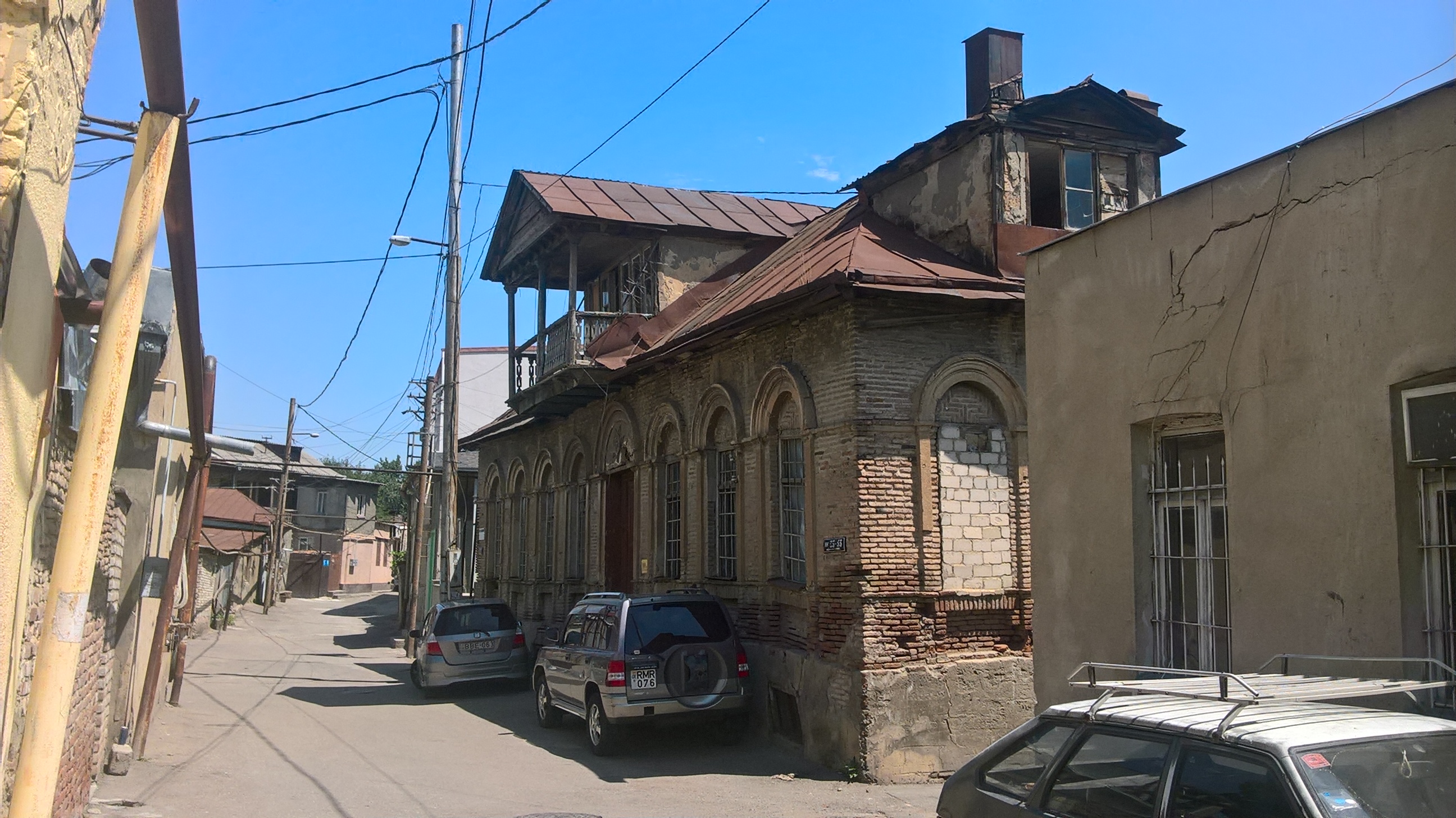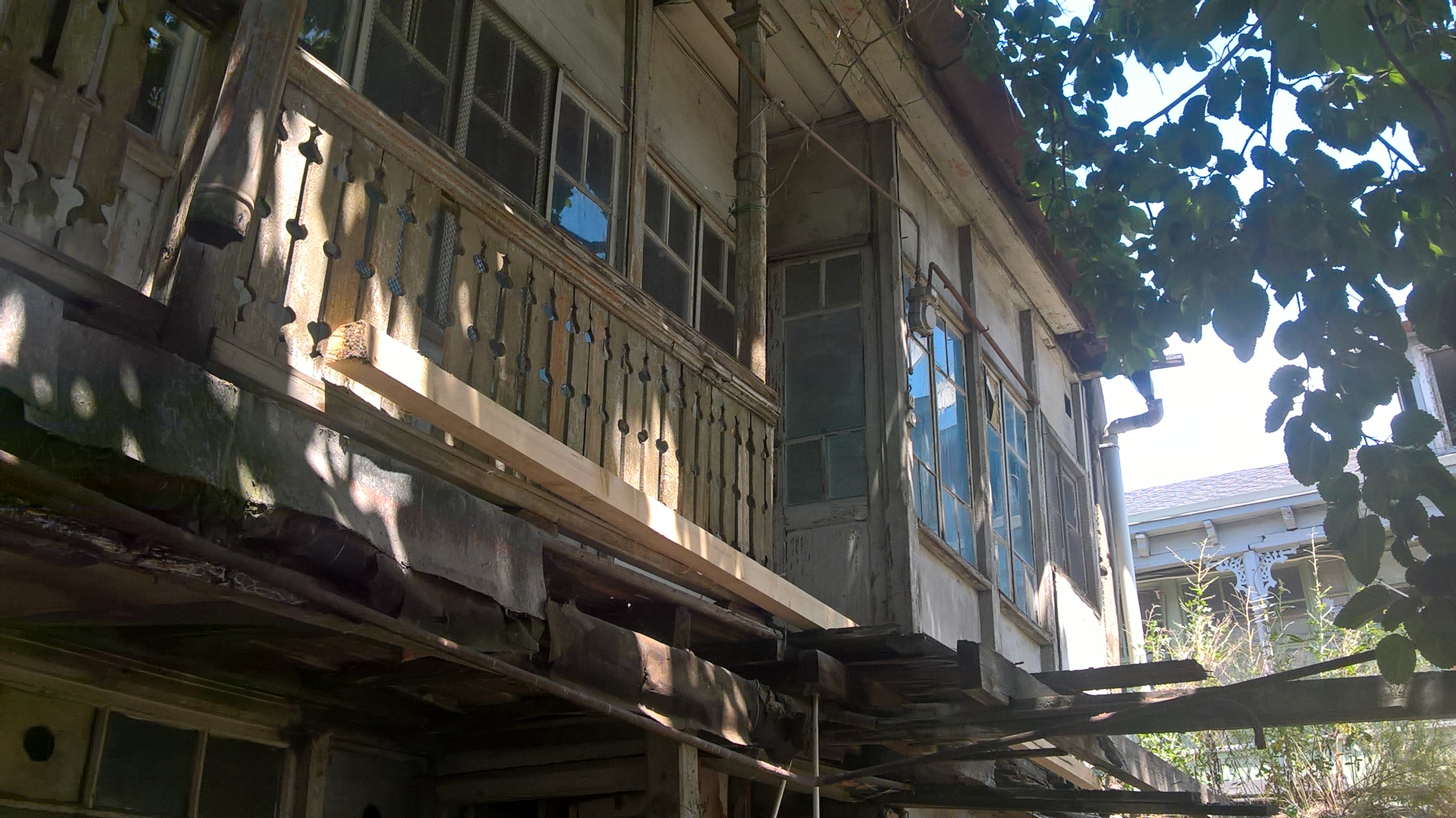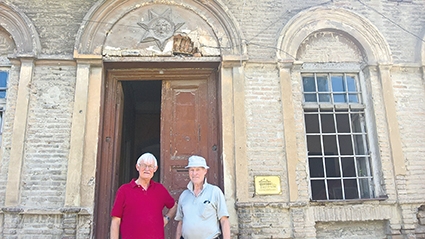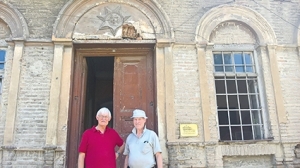Lord Hankey to Redesign Tbilisi Property for National Trust of Georgia
Lord Donald Hankey, former head of ICOMOS UK and architect, veteran of numerous prestigious heritage projects around the world, was in Georgia with structural engineer Kevin Hallaway last week, both volunteering their time to help the new National Trust of Georgia (NTG) restore its first building.
Located at 33 Solomon Brjenis Street in the Avlabari district of Georgia’s capital, the unique mid-19th century house will undergo extensive investigation and restoration should the works be funded. Lord Hankey sees great potential and has said as much in the report he is preparing for potential sponsors with Mr Hallaway.
GEORGIA TODAY went to meet the two English gentlemen at the property to find out more.
The “Tbilisi brick” house, dating back to the 1830s, is clearly in a very serious state of disrepair. The façade is cracked, with evidence of subsidence at both front corners and, inside the building, the fact that the rear extension of the property is sinking and breaking away from the main structure is apparent on entrance. Further, the décor shows an eclectic mix of flowered wallpaper in several layers and paint and shoddy masonry fix ups. No-one has lived here for decades. Yet Lord Hankey is optimistic and has a design in mind.

“The wooden floor is in excellent condition- nothing a polish can’t sort once the foundations are fixed,” he tells us. “The whole of the front wall has subsided due to water drainage. The rear is also subsiding and is what we term as ‘unfit for service.’ We have a plan from 1953 and can extrapolate a lot from that as to the original layout. It shows a lot of outbuildings in the garden [no longer present]. The Russian occupation and Shevardnadze period then saw the property packed with different families with no money available to maintain it, leading to natural damage from careless occupation in a building that is actually very important and has clear Russian influence from St Petersburg, as seen by the star and arches on the front.”
We asked what use he thought the building had had. “I’ve suggested it might have been a military barracks. Other opinions are that it was housing for the head of the local Armenian church [now destroyed] or a residence.”
Lord Hankey insists the roof space and staircase layout lends more to it having been an observation platform.
“It has a more formal Russian background, I believe, and this is something we need to puzzle out with the historians. We must also evaluate the building’s fabric- much of which is very good. There’s a lot of style hidden here- the Persian fireplaces, wooden floor…”

We ask him about his plans for the future of the building.
“We aim to make a building of use- but what that use is, is up to the NTG to decide. I merely look at theory and practise. Our objective is to leave a functional building- deciding which walls to keep and take out, for example, or which parts to alter, in order to leave it as a valuable series of useable spaces.”
One idea Lord Hankey has is to reconstruct and build up the cellar in the garden which runs along one of the adjacent streets, which could perhaps be opened as a specialty book shop, adding character to the street and bringing financial benefit to the property owners.
Also important is to bring the property up to current safety standards. “In order to ensure fire resistance to the vertical circulation, our proposal is to remove the two existing staircases and build a new staircase on the central axis,” Lord Hankey says.
One obstacle, or challenge, to any changes planned for the rear of the property is a Mulberry tree which is suspected to be older than the building itself.
“We can go up,” Lord Hankey states. “But a bit of a haircut is needed and we must be careful not to damage the root structure.”

“If you don’t reuse such historically important buildings, they fall to bits because nobody has any interest in keeping them alive,” Lord Hankey points out. “Reuse is very important. Our job here is not to define a specific use but to leave it available for multiple uses- domestic, office, or institutional. In this particular building, the quality of the original joinery and finishes demonstrates the need to upgrade and repair rather than leave it to destruction.”
The NTG website says of the building: “In October 2017, the Trust took over a unique, unusually unmolested 18th -19th century property in the Metekhi cliffs area of the city, adjoining Avlabari. The property is large enough to act as the Trust’s headquarters on a permanent basis, as well as contain space for exhibitions and events. Like so many properties in Georgia this three-story building is in a poor stage of repair, but it will slowly be restored and used as an example for locals as to how building repair can be done cheaply, effectively and with historic sensitivity, on their own homes. There will be an exhibition inside the building illustrating how this is achieved.”
We had heard before meeting Lord Hankey that this was his first trip to Tbilisi but that his wife had been here before and taken home her enthusiasm for the beauty of the place. We asked the Lord what he thought now he was here.
“Tbilisi always inspired me with its fabulous history and wonderful geographical setting. It can demonstrate how much the modern generation is prepared to destroy the past and how much great enthusiasts like Peter Nasmyth [author, founder-member of the NTG] and ICOMOS, are willing to work to maintain the historical buildings of the city. It was from the 1960s that we in the UK, coordinated by Lord Kenneth of the Labor Party, began to work to preserve English heritage, realizing how important it is to maintain our major buildings.”
We asked him if Tbilisi had met or disappointed his expectations and he told us he was “not at all saddened” to see the architecture in Tbilisi. “I’ve seen historic buildings all over the world in dreadful states and I’ve got so used to seeing it, it doesn’t faze me at all. But like here, either you get enough enthusiasm from the locals and investors to save a building, or history is lost.”
Within our conversation, the idea came up to try and enthuse youth to get involved in the historical investigation of Tbilisi’s old buildings and for them to begin to think in terms of reuse. Fabrika, a sewing factory converted into a multi-use space for bars, cafes, art studios and work spaces, is the latest prime example of such a project.
“I would be very happy to come and speak if such a program were set up,” Lord Hankey said.
About the National Trust of Georgia
In October 2016 a group of Georgian citizens and one Englishman, established a new National Trust style of organization in the Georgian capital, Tbilisi. Under the title of the National Trust of Georgia it was set up in association with the National Trust of Great Britain’s international branch INTO and follows the successful British model.
Georgia possesses a large number of historic sites worthy of saving and promoting, either as tourist venues, or workable businesses that will pay for the structure’s (or land’s) upkeep. However, the country currently has no independent national organization that enables individuals to express their concern and affection for the nation’s heritage. A National Trust of Georgia will provide this alongside a practical means of helping to preserve buildings and land. Its knowledge base and experience will help show private owners many methods to save their own properties, not as yet demonstrated by the state, plus offer a means of expressing their pride for their nation – by joining as Trust members.
By Katie Ruth Davies











